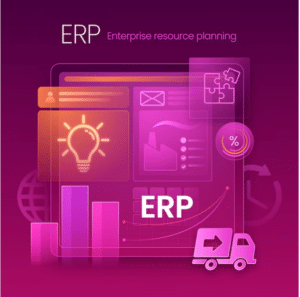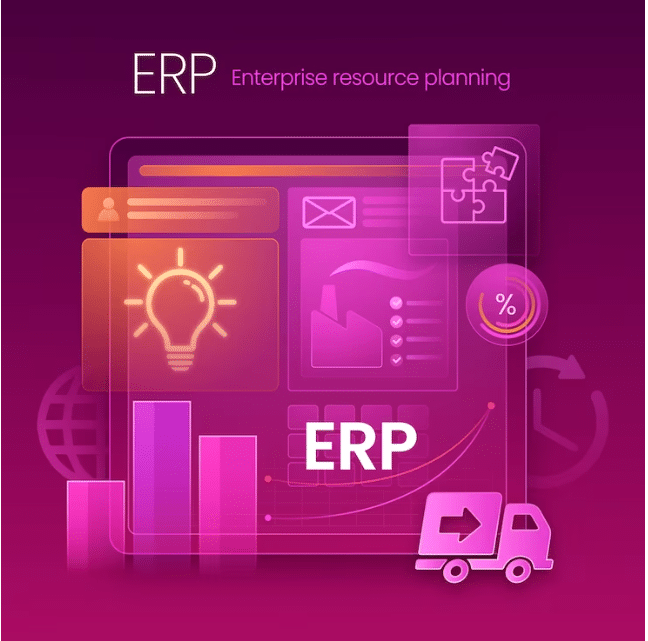stands for “Software as a Service Enterprise Resource Planning.” But let’s break that down into simpler terms. Imagine your business as a grand puzzle. Each piece represents a different aspect of your operations – from finances to inventory management, human resources to customer relations. SaaS ERP is the magical glue that seamlessly connects these pieces together. It’s like having a master conductor directing the orchestra, ensuring every note is in harmony.

In essence, SaaS ERP is a cloud-based software that streamlines and integrates various core functions of your business. This includes accounting, procurement, project management, HR, and more. All this is achieved without the hassle of traditional software installations, as everything is hosted on the cloud. Traditional ERP systems come with substantial upfront costs. Buying licenses, investing in hardware, and setting up the infrastructure can put a dent in your budget before you even begin. On the other hand, SaaS ERP operates on a subscription basis. It’s like paying a monthly rent for an apartment rather than buying the entire building. This means you can get started without a significant initial investment. It’s budget-friendly and reduces financial strain, especially for small and medium-sized businesses.
Understanding the SaaS Advantage
Now, you might wonder, “Why should I choose SaaS ERP over traditional software?” Well, that’s a great question. SaaS ERP offers a multitude of benefits. One of the key advantages of SaaS ERP is its scalability. Think of it as a piece of elastic that can stretch or shrink as needed. Traditional systems often struggle to accommodate growth, but with SaaS ERP, you can scale up or down effortlessly. As your business expands or contracts, your ERP system adapts accordingly. This scalability ensures that your ERP system remains a perfect fit for your business, whether you’re a start-up or a well-established enterprise.
- Cost-Effective: Traditional ERP systems come with substantial upfront costs. SaaS ERP, on the other hand, operates on a subscription basis, eliminating the need for hefty investments in software and hardware.
- Scalability: SaaS ERP is flexible and can adapt to your business’s evolving needs. You can scale up or down as required without major disruptions.
- Accessibility: The cloud-based nature of SaaS ERP ensures you can access your data and applications from anywhere with an internet connection. This is especially handy for businesses with remote teams or multiple locations.
- Automatic Updates: Say goodbye to the hassle of manual software updates. SaaS ERP providers handle this for you, ensuring your system is always up-to-date and secure.
- Streamlined Collaboration: With SaaS ERP, collaboration between departments becomes a breeze. Data is shared in real-time, fostering better decision-making and teamwork.
How SaaS ERP Works
To demystify this further, think of SaaS ERP as your personal wizard. It centralizes your data, making it available to all relevant departments. Let’s say your sales team lands a big contract. With SaaS ERP, the sales department can instantly update inventory levels, prompting the procurement department to restock. Simultaneously, the finance team can prepare for incoming revenue, all while HR plans to onboard new staff to meet the demand. In simpler terms, SaaS ERP automates workflows, reducing manual tasks, errors, and delays. It’s your business’s best friend, ensuring that everything runs smoothly. The cloud-based nature of SaaS ERP ensures that your business is always within reach. It’s like having your office in your pocket. Whether you’re at your desk, in a coffee shop, or even traveling, as long as you have an internet connection, you can access your SaaS ERP. This is a game-changer for businesses with remote teams, multiple locations, or employees on the go. Your data and applications are at your fingertips, ensuring you can make informed decisions and take action wherever you are.
Choosing the Right SaaS ERP Solution
Selecting the perfect SaaS ERP solution for your business can be a daunting task, like picking the right car from a showroom with countless options. Here are some key points to consider, Traditional software often requires manual updates. It’s like maintaining a car – you need to regularly check, repair, and upgrade various parts. SaaS ERP simplifies this by handling updates automatically. It’s akin to a self-updating car that not only performs maintenance itself but also continuously improves its performance. With SaaS ERP, you can be confident that your system is always up-to-date, secure, and equipped with the latest features. Say goodbye to the hassle of managing updates and patches, leaving you with peace of mind to focus on your core business.
- Business Needs: Identify your specific requirements. Do you need robust financial management, comprehensive reporting, or a focus on supply chain management? Choose a solution that aligns with your goals.
- Scalability: Ensure the software can grow with your business. You don’t want to outgrow your ERP solution and face the hassle of migration.
- User-Friendly Interface: The best SaaS ERP solutions offer intuitive interfaces that your team can quickly adapt to.
- Vendor Reputation: Research the vendor’s reputation. Read reviews, ask for references, and ensure they have a track record of delivering quality service and support.
- Data Security: Your data is invaluable. Choose a SaaS ERP solution with robust security measures in place to protect your information.
SaaS ERP in Action: Real-Life Examples
Now that we’ve covered the basics, let’s see how SaaS ERP is making a real impact. Two prime examples are, Imagine your business as a complex network of departments, each with its specific tasks and responsibilities. SaaS ERP acts as the bridge that connects these departments seamlessly. It’s like a superhighway for data, ensuring it flows freely across your organization. With real-time data sharing and collaboration tools, SaaS ERP fosters better decision-making and teamwork. It breaks down the silos between departments, making information accessible to those who need it, when they need it. This seamless collaboration results in improved efficiency, enhanced productivity, and ultimately, better outcomes for your business. In conclusion, the SaaS advantage is all about cost-effectiveness, scalability, accessibility, automatic updates, and streamlined collaboration. These benefits make SaaS ERP a powerful choice for businesses of all sizes, helping them streamline operations, boost productivity, and stay competitive in an ever-evolving marketplace. So, if you want to take your business to the next level, it’s time to embrace the advantages of SaaS ERP.
- Salesforce: Known for its customer relationship management (CRM) capabilities, Salesforce uses SaaS ERP to streamline sales processes, manage customer data, and provide actionable insights.
- NetSuite: This cloud-based ERP system is favored by a wide range of industries, offering comprehensive solutions for finance, HR, and e-commerce.
Measuring the ROI of SaaS ERP
Return on Investment (ROI) is a crucial metric for any business decision. SaaS ERP offers a significant return through increased productivity, cost savings, and improved decision-making. As your business operations become more efficient, the ROI of your SaaS ERP investment becomes increasingly evident. It’s like planting seeds that grow into flourishing trees. Create a detailed migration plan that outlines what data needs to be moved, in what order, and how. Before the migration, ensure that you have a reliable backup of all your data. This serves as a safety net in case of any unexpected issues during the migration.
Overcoming Common Challenges
Every journey has its challenges, and implementing SaaS ERP is no exception. Here are some hurdles you might encounter, Every journey has its challenges, and implementing SaaS ERP is no exception. It’s like embarking on an adventure filled with obstacles and hurdles. However, with the right strategies and preparation, you can overcome these challenges and ensure a successful transition to SaaS ERP.
- Data Migration: Moving your data from legacy systems can be complex. Ensure a smooth transition plan and backup measures.
- User Adoption: Introducing a new system can be met with resistance. Provide proper training and incentives to encourage adoption.
- Integration: Ensuring SaaS ERP integrates seamlessly with your existing software is vital for uninterrupted operations.
- Customization: Tailoring the software to your unique needs might require technical expertise. Be prepared to invest in customization if necessary.
Security in the SaaS ERP World
Security is a top concern, much like guarding a treasure chest. SaaS ERP providers invest heavily in security measures to protect your data. They employ encryption, secure data centers, and regular security audits to ensure your information remains confidential and safe. Consider involving professionals who specialize in data migration to ensure a smooth and secure transfer. Introducing a new system to your team can be met with resistance. Change can be intimidating, and some employees may be hesitant to embrace the new technology. To overcome this challenge.
The Future of SaaS ERP
SaaS ERP is continually evolving. We can liken it to a dynamic river, always flowing and adapting. With advancements in artificial intelligence and machine learning, SaaS ERP is becoming smarter, offering predictive analytics and even more seamless integration. As businesses continue to embrace digital transformation, SaaS ERP will play a pivotal role in shaping the future of operations. Ensuring that SaaS ERP integrates seamlessly with your existing software is vital for uninterrupted operations. It’s like ensuring all the pieces of a puzzle fit perfectly together. To overcome this challenge:
- Choose Compatible Software: When selecting a SaaS ERP solution, make sure it is compatible with the other software your business relies on.
